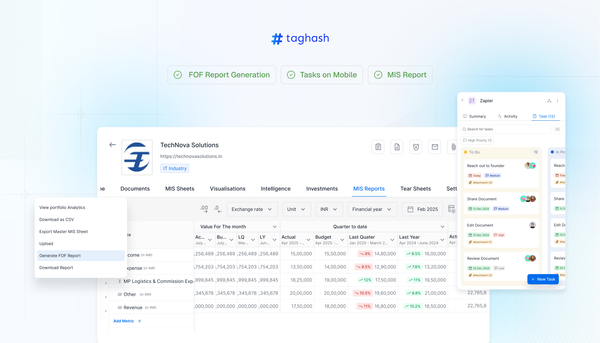Measuring the Improbable - How To Assess Startup Potential
Ways to value a start-up.

Valuation as the Cornerstone of Early-Stage Investment Strategy
Assessing the worth of a startup at its earliest stages is a fundamental exercise that blends analytical rigor with strategic foresight. For venture capitalists, valuation serves as more than a financial checkpoint; it is the foundation for a partnership predicated on shared growth ambitions and aligned incentives. Getting this right is critical as it shapes investment returns, ownership stakes, and long-term value creation.
Why Accurate Valuation Matters for Venture Capital
Startup valuation is inherently complex due to limited historical data, unpredictable market conditions, and unproven business models. However, it remains central to negotiations between founders and investors. A well-substantiated valuation protects both parties, ensuring that founders retain meaningful ownership while providing investors with a clear path to potential returns.
Beyond immediate financial metrics, valuation enables VCs to quantify belief in the founding team’s vision, the scalability of the business model, and the market’s readiness for disruption. This alignment minimises future disputes and sets the tone for a value-driven relationship.
Key Valuation Methodologies Shaping Investment Decisions
Venture Capital Method: Outcome-Driven Forecasting
This method starts by estimating the startup’s potential exit value, whether through acquisition or public offering. VCs calculate backward from this projected outcome, applying their target rate of return to arrive at a present-day valuation. This approach keeps investors focused on scalability and return potential while rationalising the risk inherent in early-stage ventures.
Berkus Method: Quantifying Intangible Assets
Originally designed for seed-stage companies, the Berkus Method attributes specific monetary values to critical qualitative factors, including product development, market readiness, management strength, strategic relationships, and early traction. This framework recognizes that, in the absence of revenues, the true value often lies in the strength of the founding team and the problem-solving potential of the product.
Scorecard Valuation Method: Benchmarking Against Market Norms
The Scorecard Method adjusts a startup’s valuation by comparing it to similar early-stage companies within the same sector or geography. Key factors, such as team capability, market size, competitive positioning, and technology differentiation, are weighted to refine valuation estimates. This model ensures market realism and relative fairness in early-stage investing.
Risk Factor Summation Method: A Layered Risk Approach
This method systematically identifies and weighs critical risk factors across various dimensions, including technology, market adoption, regulatory challenges, and execution capability. Each risk is quantified, leading to adjustments in the baseline valuation. By isolating individual risks, investors gain a clear understanding of where the startup must execute flawlessly to justify investment.
Discounted Cash Flow Method: Grounding Value in Future Earnings
The DCF model projects future cash flows and discounts them back to present value, reflecting both the time value of money and risk premium. While ideal for later-stage startups with predictable revenue streams, DCF remains challenging for early ventures due to uncertain financial forecasts. Nonetheless, it reinforces financial discipline in projections.
Comparable Transactions Method: Anchoring to Market Dynamics
Analyzing recent transactions involving similar startups provides a reality check, preventing valuations from deviating too far from prevailing market norms. This method leverages multiples of revenue, user base, or other operational metrics, aligning startup valuations with current investor appetite and market sentiment.
Book Value Method: A Conservative Asset-Based Perspective
Though less relevant for asset-light technology startups, this approach considers the net asset value of the business. For capital-intensive ventures, it offers a baseline for minimum valuation but rarely captures the full potential of innovative startups with intangible assets.
First Chicago Method: Scenario-Based Valuation Framework
By modeling multiple potential outcomes - optimistic, moderate, and pessimistic- this hybrid approach assigns probabilities to each scenario. The weighted average valuation derived offers a nuanced view, balancing the outsized potential of success against the ever-present risk of failure.
What Investors Prioritize Beyond Financial Models
While valuation frameworks offer structure, seasoned investors know that models are directional, not definitive. Ultimately, decisions are shaped by qualitative factors that signal long-term viability:
- Founding Team Excellence: Investors prioritise entrepreneurs with clarity of purpose, execution capability, and resilience.
- Market Size and Growth Potential: VCs favor industries where even moderate market penetration delivers outsized returns.
- Product-Market Fit: Solutions that resonate deeply with users and demonstrate early traction stand out.
- Defensible Moats: Competitive advantages that strengthen over time, whether through network effects, proprietary technology, or regulatory barriers, remain critical.
Investors rely on these signals to bridge the gap between what the spreadsheet shows and what the market may ultimately reward.
Startup Valuation as a Strategic Narrative
At its core, startup valuation is less about present conditions and more about a shared belief in future possibilities. It reflects the conviction that, under the right circumstances, an improbable idea can evolve into a transformative business.
For venture capitalists, valuation is a disciplined attempt to price ambition, innovation, and execution risk. It is not a static number but a dynamic narrative that evolves with every milestone the startup achieves. Success, therefore, depends not merely on modeling but on the investor’s ability to see potential where others see only uncertainty.
Final Thoughts - A Framework for Navigating Uncertainty
Venture capitalists do not invest based on what is likely to happen most of the time; they invest based on what happens if everything works. Valuation is their tool for managing this tension, quantifying belief while safeguarding capital.
By embracing structured valuation models and integrating qualitative insights, investors craft an informed perspective on startups’ potential trajectories. This dual lens ensures that venture capital continues to play its vital role, fueling the improbable ventures that shape the future economy.
About Taghash
Taghash provides an end-to-end platform for venture funds, private equity, fund of funds, and other alternative investment funds. Over the last seven years, we have served as the tech arm for top VCs, helping them manage operations across deal flow, portfolio, fund, and LP management. Trusted by leading fund managers like Blume Ventures, Kalaari Capital, and A91 Partners, we enable our clients to achieve greater success. Click here to book a demo.




